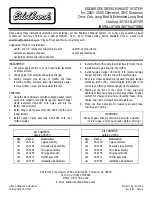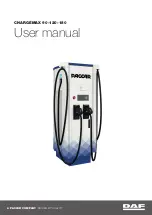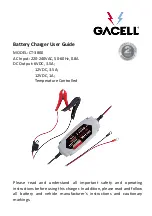
PREMIUM VIII WARNINGS
Distracting the driver from traffic can lead to collisions and injuries. Using the radio
system while driving can distract from traffic.
• Observe legal regulations.
• Always drive attentively and responsibly.
• Setting the volume too high can damage the hearing. This applies especially to
volumes above about 85 decibels.
• Select volume settings so that acoustic signals from the outside are always
audible (for example, the sirens of emergency rescue vehicles).
• Please lower the volume before changing or connecting to an audio source.
Unmounted or improperly mounted external devices can be thrown through the
passenger compartment in the event of a sudden driving or braking maneuver
or a collision, causing injury.
• Never leave external devices in the doors, on the front windshield, on or near
the area marked “AIRBAG” on the steering wheel, instrument panel, seatbacks,
or between these areas and the occupants. External devices can cause serious
injury in the event of a collision, especially if the airbags inflate.
• Connecting cables of external devices may obstruct the driver. Route cables so
as not to interfere with the driver.
• The armrest can affect the elbow room of the driver and thus cause collisions
and severe injuries. Always keep the armrest closed while driving.
• Injuries can be caused by invisible laser beams if the housing of the CD
player is opened. Have the CD player repaired only by a specialist.
TIRE PRESSURE MONITORING SYSTEM WARNINGS
Incorrect tire pressures and/or underinflation can cause sudden tire failure, loss
of control, collision, serious personal injury or even death.
• When the warning symbol appears in the instrument cluster, stop and inspect
the tires.
• Incorrect tire pressure and/or underinflation can cause increased tire wear and
can affect the handling of the vehicle and stopping ability.
• Incorrect tire pressures and/or underinflation can also lead to sudden tire failure,
including a blowout and sudden deflation, causing loss of vehicle control.
• The driver is responsible for the correct tire pressures for all tires on the vehicle.
The recommended tire pressure values are listed on a sticker inside the
driver door.
• The TPMS can only work correctly when all tires on the vehicle are filled to the
correct cold tire inflation pressure specified for the tires installed on the vehicle.
• Using incorrect tire pressure values can cause accidents or other damage.
Always inflate the tires to the correct specified cold tire pressure values for the
tires installed on the vehicle.
• Always maintain correct cold tire inflation pressure so that TPMS can do its job.
• Always inflate tires to the recommended and correct tire pressure before
driving off.
• Driving with underinflated tires causes them to flex (bend) more, letting them get
too hot, resulting in tread separation, sudden tire failure, and loss of control.
• Excessive speed and/overloading can cause heat build-up, sudden tire failure
and loss of control.
• If the tire pressure is too low or too high, the tires will wear prematurely and the
vehicle will not handle well.
• If the tire is not “flat” and you do not have to change a wheel immediately, drive
carefully and at reduced speed to the nearest service station to check the tire
pressure and add air as required.
• When replacing tires or wheel rims on vehicles equipped with TPMS always read
and heed the information and all WARNINGS regarding Tires and wheels.
WINDSHIELD WIPER WARNINGS
Windshield washer fluid without enough frost protection can freeze on the
windshield and reduce visibility.
• Use the windshield washer system with enough frost protection for winter
temperatures.
• Never use the windshield wipers/washers when it is freezing without first
defrosting the windshield. The washer solution may freeze on the
windshield and reduce visibility.
• Worn or dirty wiper blades reduce visibility and increase the risk of accidents
and severe injuries.
• Always replace wiper blades that are worn, damaged, or do not keep the
windshield clear.
KEY FOB WARNINGS
Improper use of vehicle keys can result in serious personal injury.
• Always take the key with you when you leave the vehicle. It can be used to start
the engine and operate vehicle systems such as the power windows, leading to
serious personal injury. Children or other unauthorized persons could also lock
the doors and the luggage compartment.
• Never leave children, disabled persons, or anyone who cannot help themselves
in the vehicle. The doors can be locked with the remote control key. This could
result in people being trapped in the vehicle in an emergency. For example,
depending on the time of year, people trapped in the vehicle can be exposed to
very high or very low temperatures.
• Heat build-up in the passenger and luggage compartment of a parked vehicle
can result in temperatures in the vehicle that are much higher than outside
temperatures, particularly in summer. Temperatures can quickly reach levels
that can cause unconsciousness and death, particularly to small children.
• Never remove the key from the ignition switch while the vehicle is moving or
rolling to a stop. The steering wheel will lock and you will not be able to steer
or control the vehicle.
NAVIGATION WARNINGS
Operating the radio navigation system while driving can distract from traffic and
lead to accidents.
• Observe legal regulations.
• Always drive attentively and responsibly.
• Setting the volume too high can damage the hearing. This applies especially to
volumes above around 85 decibels.
• Select volume settings so that acoustic signals from the outside are audible (for
example, the sirens of emergency rescue vehicles).
• Inserting data media while driving can distract from traffic and lead to accidents.
Always keep the storage compartment closed while driving.
• Always keep the armrest closed while driving. The center armrest can interfere
with the driver’s elbow movement and thus cause collisions and severe injuries.
CLIMATRONIC
®
WARNINGS
Poor visibility increases the risk of collisions and other accidents that cause serious
personal injuries.
• Always make sure all windows are clear of ice, snow, and condensation for good
visibility to the front, sides, and rear.
• Maximum heating output and fast defrosting will only be possible after the engine
has reached operating temperature. Wait until you have good visibility before
driving off.
• Always make sure you know how to properly use the heating and ventilation
systems as well as the rear window defogger that you will need for good visibility.
• Never use air recirculation for long periods of time. When the air conditioner is
off and recirculation mode is on, condensation can quickly form on the windows
and greatly reduce visibility.
• Always switch off recirculation mode when it is not needed. Stale air causes
driver fatigue and reduces driver alertness, which can cause accidents, collisions,
and serious personal injury.
• Never switch off the fan for a long period of time and never use air recirculation a
long period of time because no fresh air will come into the passenger compartment.
CRUISE CONTROL WARNINGS
Using the cruise control when it is not possible to drive safely at a constant speed
can be dangerous and can lead to an accident and serious personal injuries.
• Never use cruise control when driving in heavy or varying traffic or when you
cannot keep a safe distance between you and the vehicles ahead of you.
• Never use cruise control on steep, winding, or slippery roads (such as gravel
roads, wet roads, or snowy or icy roads) or on roads with standing water.
• Never use cruise control when driving off-road or on unpaved roads.
• Always adjust your speed and the distance you keep between you and the
vehicles ahead of you to the road, traffic, weather and visibility conditions.
• To help prevent unintended operation of cruise control, switch the system off
when it is not being used.
• It is dangerous to use the Resume feature when the previously set speed is too
high for the existing road, traffic, or weather conditions.
• When traveling downhill, the cruise control may not be able to maintain a
constant speed. The vehicle may speed up because of its own weight. Downshift
and/or use the foot brake to slow the vehicle.
IPOD
®
ADAPTER WARNINGS
Driver distraction, including the operation of external audio devices, can cause
accidents and serious personal injury.
• Always focus your undivided attention on driving the vehicle.
• Never display video images in the display when the vehicle is moving.
• Use the radio navigation system only if road, traffic, and weather conditions
permit and you will not be distracted from your driving.
• Always obey applicable laws regarding the use of displays when the vehicle
is moving.
• Always adjust volume so that horns and warning sounds from outside the vehicle
(police and fire truck sirens, for example) can be clearly heard at any time.
• Observe legal regulations.
• Always drive attentively and responsibly.
• Setting the volume too high can damage the hearing. This applies especially to
volumes above about 85 decibels.
• Select volume settings so that acoustic signals from the outside are always
audible (for example, the sirens of emergency rescue vehicles).
• Please lower the volume before changing or connecting to an audio source.
• Unmounted or improperly mounted external devices can be thrown through the
passenger compartment in the event of a sudden driving or braking maneuver or
an accident, causing injury.
• Never leave external devices in the doors, on the front windshield, on or near the
area marked “AIRBAG” on the steering wheel, instrument panel, seat backs, or
between these areas and the occupants. External devices can cause serious
injury in the event of an accident, especially if the airbags inflate.
• Connecting cables of external devices may obstruct the driver.
• Route cables so as not to interfere with the driver. The armrest can affect the
elbow room of the driver and thus cause accidents and severe injuries.
• Always keep the armrest closed while driving.
BLUETOOTH
®
WARNINGS
• Collisions and injuries can occur if the driver is distracted. Speaking on or using
a phone while driving can distract the driver from traffic.
• Select the volume settings so that the acoustic signals from the outside are
still audible (for example, the sirens of emergency rescue vehicles). Observe
legal regulations.
• In areas with no or poor mobile network coverage and possibly in tunnels,
garages and subways, phone conversations may be interrupted, and it may be
impossible to make phone calls–even emergency calls!
• In some countries, emergency calls may only be supported when the mobile
phone is connected to a mobile phone package which has a SIM card that is
“not blocked” and/or has sufficient credit on it.
• Unmounted or improperly mounted mobile phones can fly around in the event
of a sudden driving or braking maneuver or a collision. This may cause injuries.
• Never place or mount a mobile phone on doors, on the windshield or on or near
the area on the steering wheel marked “AIRBAG,” the instrument panel, the seat
backrests or the areas between these points and the driver/passengers. Mobile
phones can lead to serious injuries in cases of collisions, especially when the
airbags are inflated.
• Always switch off your mobile telephone at gas stations or wherever there is a
fire or explosion hazard. Electromagnetic radiation can cause sparks which can
start fires.
• The mobile phone will automatically connect to the mobile network when the
Bluetooth connection to the mobile phone package is disconnected.
• Using a radio device in the vehicle without a connection to an external antenna
might exceed electromagnetic radiation thresholds. This also applies if the
external antenna is not installed properly.
• Keep a distance of at least eight inches between the antennas of the mobile
phone and the pacemaker, since mobile phones can affect the functionality of
a pacemaker.
• Do not carry a mobile phone on standby mode in the breast pocket directly on
top of a pacemaker.
• If interference is suspected, immediately switch off the mobile phone.
Important Safety Warnings
Содержание 2011 CC
Страница 1: ...2013 CC Quick Start Guide...






























